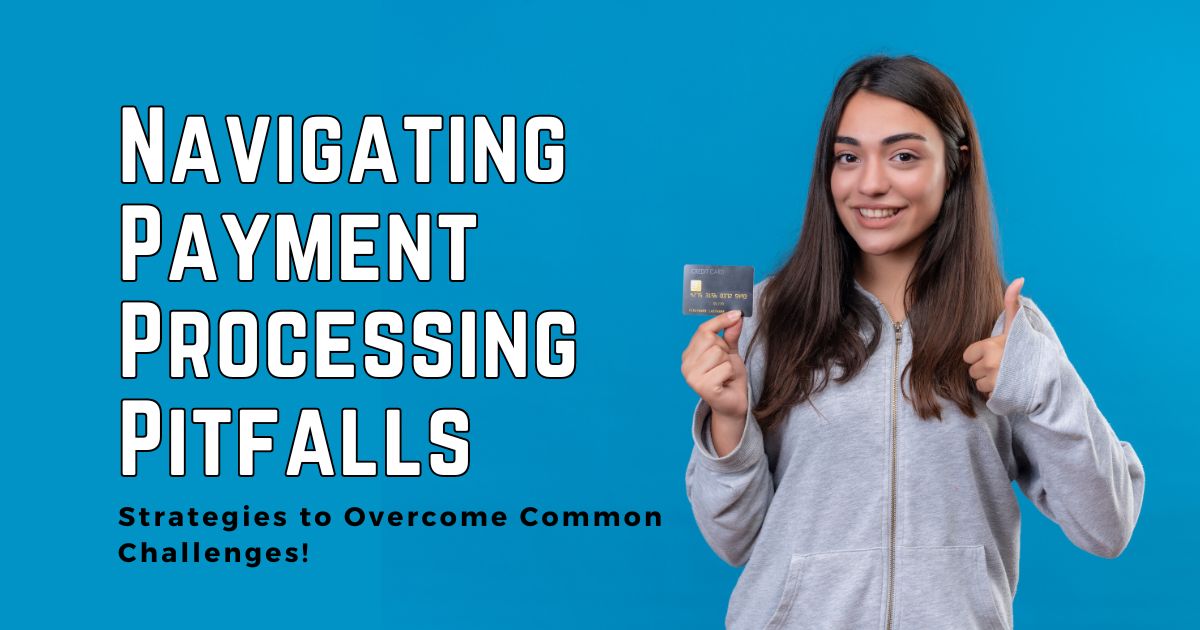
| February 14th, 2024 |
Navigating Payment Processing Pitfalls — Strategies to Overcome Common Challenges!
In the fast-paced world of commerce, efficient payment processing is crucial for businesses to thrive. However, navigating the intricate landscape of financial transactions comes with its own set of challenges. From technological hiccups to regulatory complexities, the road to seamless payment processing is often fraught with obstacles. In this comprehensive blog, we’ll delve into the common challenges faced by businesses in payment processing and provide insightful strategies to overcome them.
Fraud Prevention and Security Concerns —
Challenge:
One of the foremost challenges in payment processing is the constant threat of fraud and security breaches. As technology evolves, so do the tactics of cybercriminals. From phishing attacks to data breaches, businesses must stay vigilant to protect sensitive customer information and maintain trust.
Solution:
Implement robust fraud prevention measures, including advanced encryption technologies, multi-factor authentication, and real-time monitoring systems. Regularly update security protocols and educate staff on cybersecurity best practices to create a fortified defense against potential threats.
Payment Gateway Integration Issues —
Challenge:
The integration of payment gateways with diverse platforms and systems can be a complex task. Incompatibility issues, system downtimes, and difficulties in ensuring a seamless user experience pose significant challenges for businesses relying on efficient payment processing.
Solution:
Choose a reliable and flexible payment gateway that aligns with your business needs. Conduct thorough testing before implementation and stay informed about updates to ensure compatibility with existing systems. Regularly monitor performance metrics and promptly address any integration issues to maintain a smooth transactional flow.
Regulatory Compliance and Legal Frameworks —
Challenge:
The global financial landscape is governed by a myriad of regulations, and businesses must navigate complex legal frameworks to ensure compliance. Failure to adhere to these regulations can result in severe penalties and reputational damage.
Solution:
Stay abreast of regulatory changes in the regions where your business operates. Employ legal experts or consultants to interpret and implement compliance measures effectively. Regularly audit processes to ensure adherence to relevant laws and regulations, fostering a culture of compliance within the organization.
Payment Delays and Cash Flow Management —
Challenge:
Delayed payments can disrupt cash flow, affecting a business’s ability to meet financial obligations. Manual processing, invoicing errors, and lengthy approval processes contribute to payment delays, posing a significant challenge for organizations.
Solution:
Automate invoicing and payment processes to minimize errors and expedite transactions. Implement a robust credit management system to assess customer creditworthiness and establish clear payment terms. Utilize analytics tools to forecast cash flow and identify potential bottlenecks before they become critical issues.
Cross-Border Transaction Complexities —
Challenge:
For businesses engaged in international trade, cross-border transactions present unique challenges. Currency conversions, varying regulatory landscapes, and different payment methods across regions can complicate payment processing.
Solution:
Partner with financial institutions experienced in cross-border transactions. Utilize multi-currency accounts to minimize currency conversion costs and leverage technology to stay informed about regulatory requirements in different jurisdictions. Choose payment methods that are widely accepted internationally to enhance transactional efficiency.
Customer Disputes and Chargebacks —
Challenge:
Disputes and chargebacks can strain merchant-customer relationships and impact the overall profitability of a business. Managing and resolving these issues efficiently is crucial for maintaining customer trust.
Solution:
Implement transparent and clear refund policies. Provide detailed product information and excellent customer service to minimize the likelihood of disputes. Utilize chargeback prevention tools and promptly address customer concerns to resolve issues before they escalate.
Technological Obsolescence and System Upgrades —
Challenge:
Technology evolves rapidly, and businesses relying on outdated payment systems may face compatibility issues, security vulnerabilities, and a lack of support for new features and functionalities.
Solution:
Regularly assess the technological landscape and invest in scalable, future-proof payment solutions. Implement system upgrades and updates proactively to ensure compatibility with emerging technologies. Collaborate with tech partners to stay ahead of the curve and leverage the latest advancements in payment processing.
Limited Payment Options and User Experience —
Challenge:
Providing a limited range of payment options can hinder customer satisfaction and impact conversion rates. Additionally, a subpar user experience during the payment process can lead to abandoned transactions.
Solution:
Diversify payment options to cater to a broader customer base. Offer popular methods such as credit cards, digital wallets, and bank transfers. Prioritize user experience by optimizing the checkout process, ensuring mobile compatibility, and providing clear instructions to enhance overall satisfaction.
Data Security Compliance in E-commerce —
Challenge:
E-commerce businesses handling vast amounts of customer data face additional challenges in ensuring compliance with data security standards such as PCI DSS. Non-compliance can result in fines and damage the reputation of the business.
Solution:
Adopt secure payment gateways that comply with industry standards. Regularly conduct security audits and vulnerability assessments. Encrypt sensitive customer data and limit access to authorized personnel. Educate employees about data security protocols to create a secure e-commerce environment.
Resource Constraints and Scalability —
Challenge:
Growing businesses may face resource constraints when scaling their payment processing infrastructure. Inadequate resources can lead to performance issues, delays, and a compromised customer experience.
Solution:
Plan for scalability from the outset, choosing payment solutions that can grow with your business. Cloud-based payment processing systems offer flexibility and scalability. Regularly assess your infrastructure requirements and allocate resources accordingly to ensure seamless scalability.
In conclusion, the challenges in payment processing are diverse and evolving, requiring a proactive and adaptive approach from businesses. By embracing innovative technologies, prioritizing security and compliance, and optimizing user experiences, organizations can overcome these challenges and create a robust payment processing ecosystem. Staying informed, investing in the right tools, and fostering a culture of continuous improvement will position businesses to thrive in the ever-changing landscape of financial transactions.
